Text
The Occult and Occultism
This week we are going to take a look at some of our works from the interesting genre and practice of the occult and occultism. The word ‘occult’ derives from the Latin word ‘occultus’ which translates as clandestine, hidden or secret. In English usage the word has developed to typically refer to paranormal knowledge. However, there are many branches of the occult and practices which includes, but is not limited to, magic, alchemy, extra-sensory perception, astrology, spiritualist religion, and divination.
Of many exciting works in our library, the first title to be discussed is Jane Sherwood’s fascinating Post-Mortem Journal, Communications from T.E Lawrence.The work is a biography of sorts on Lawrence of Arabia. The entire novel was reported by Jane Sherwood through the process of automatic writing. Sherwood stated she had communications with someone from the other side of the grave named ‘Scott.’ This ‘Scott’ did not believe himself to truly be dead and so this work shows the development of salvation for him. It transpired that ‘Scott’ was actually Colonel T E Lawrence. Lawrence, also known as 'Lawrence of Arabia', was a British archaeologist, military officer, diplomat and writer. The flyleaf refers to the Lawrence as ‘A tortured and guilty man who, for the first time, is forced into admitting his weaknesses and vanities during his earthly life... such revelations are harrowing and magnificent.’
Sherwood notes that the work is directly from ‘Scott’ and therefore she can only vouch for her own honesty as she has written without addition or modification through the form of automatic writing. This work is a fascinating insight into Lawrence's life and his journey to salvation.
Another branch of occultism is Occult science, of which we have many works by noted occultist and Theosophist, Alice Bailey. Bailey brought the idea of occult science into association with esoteric astrology. She also wrote most of her works through a form of automatic writing. She described her works to have been telepathically dictated to her by a Master of Wisdom referred to as ‘The Tibetan’ or by the initials ‘D L.’ ‘D L’ was also known as Master Djwhal Khul.
Bailey was a writer of more than twenty-four books on theosophical subjects. She was also one of the first people to use the term ‘New Age.’ Her works of occult science tend to relate to how spirituality relates to the Solar System as well as meditation, healing, spiritual psychology and more. We have a second edition of Bailey’s work Telepathy and the Etheric Vehicle. The work is a study and explanation of telepathy with regards to the etheric body. The etheric body is the vehicle or instrument of astral energy. Another important work by Bailey is The Light of the Soul, Its Science and Effect. The work is on Yoga tradition and Pantanjal’s sutras on Yoga. It discusses the stages of meditation, powers of the soul, steps to union as well as a discussion of the versatile psychic nature. To see more of our works written by Alice Bailey click here.
Under the branch of occult science we have a work by Canadian astrologer and mystic, Manly P Hall. Man, The Grand Symbol of the Mysteries is a really interesting work on human anatomy in terms of occult knowledge. Subjects discussed to this work include the theory of education, occult foundations of science, the three worlds, the symbolism of the world egg, occult embryology, incarnations of Vishnu, the brain, senses and much more. Our copy is the third edition, published the same year as the first edition. It is illustrated with several interesting vignettes, diagrams and full page illustrations.
As ever, this blog only discusses a small sample of the many works in our library. If you are looking for anything in particular please do not hesitate to contact us. Otherwise, feel free to peruse our website.
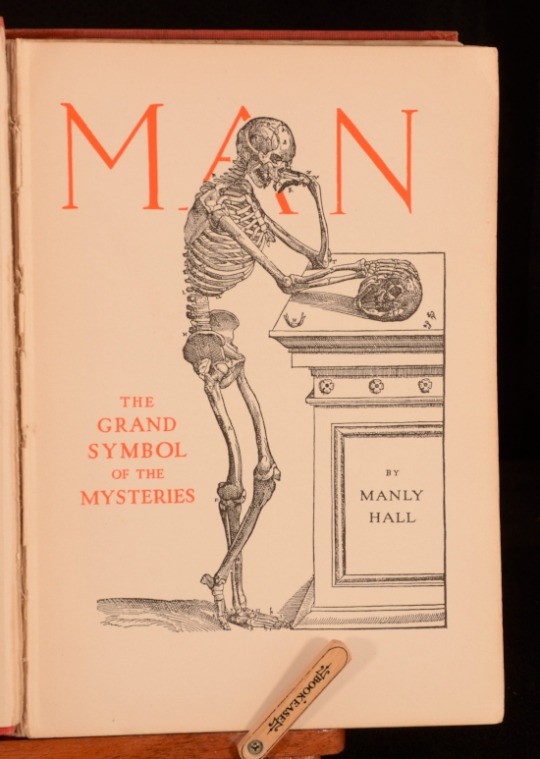
#Occult#Occultism#Theosophy#MondayBlog#Monday Blogs#Books#Bibliophile#Book Blogs#Book Blogger#Reading#Lawrence of Arabia#Occult Anatomy#Anatomy#Blogger#Blogs about Books
0 notes
Photo

A wise quote by Milton on this bookplate 📚
#books#book quotes#quotes about books#quotes about reading#bibliophile#book#book lover#books books books#bookish#love reading#life quotes#quotes to live by#booklr#books are life#reading is life#antiquebooks#antiquarian#bookplate#bookplatejunkie#this book belongs to#john Milton#Milton quotes#reading#book nerd#booknerds#mondaymotivation#Monday#book blog#bookworm
1 note
·
View note
Photo
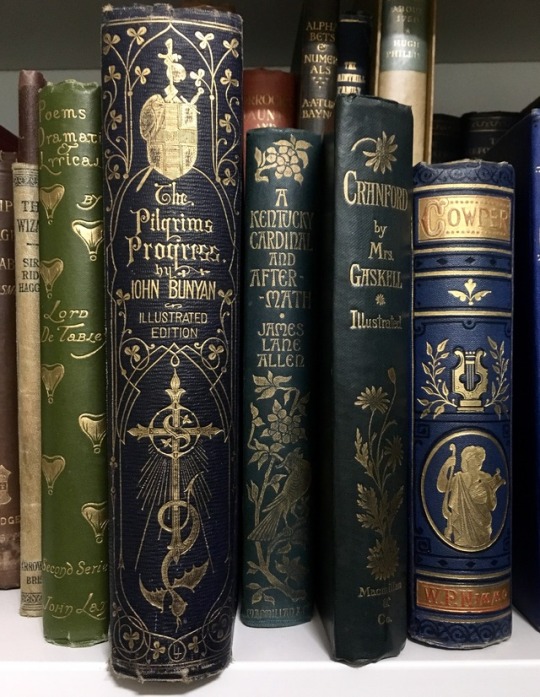
Some of our many publisher’s bindings.
#publishers binding thursday#publishers binding#bibliophile#bookish#bookshelf#shelfie#clothbound#booklover#beautiful books#gilt#gilt stamped#decorative books#decorative binding#pictorial cloth#pictorial bindings#poetry#national poetry day#allegory#illustrated#booklr#book blog#bookseller#bookworm#books books books#old books#books everywhere#shelf#bookshelfie#library#library shelf
11 notes
·
View notes
Photo
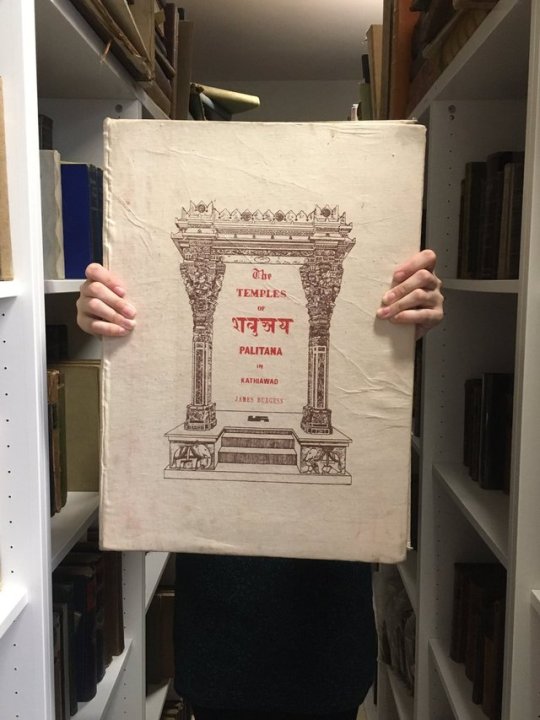
It’s #waytoobigwednesday. Here is a commemorative work on the temples and shrines of Satrunjaya/Shatrunjaya.
This particular copy was published for the celebration of the 2500th anniversary of Bhagwan Mahavira Nirvan in 1975/6.
However, this fascinating work by James Burgess was originally published in 1869.
#jainsim#Jain#Tirthankara#Shatrujaya#Temple#Gujurat#History#Archaeology#India#Illustrated#Oversized#Oversized Books#Reading#Love Books#Bibliophile#Library#Wednesday Wisdom#Nirvana
1 note
·
View note
Text
Banned Books Week
The 24th-30th September marks 'Banned Books Week'. The intention of this week is to celebrate the freedom to read. Below we have selected some works from our library that were previously censored.
Our first work, Uncle Tom’s Cabin, centres on the horror and immorality of slavery. Published in 1852, these themes did not align with the Confederacy, which heavily relied upon slavery as a means to sustain its agricultural economy. As such, this book was banned during the Civil War, as a protest from the defenders of slavery and a way to minimise response from abolitionists. Our edition of Uncle Tom’s Cabin is the first official copy to be released in the UK. Prior to this, several unofficial copies had been produced and circulated. Whilst much controversy surrounded Stowe’s work, the reason for censorship in the UK was vastly different to those voiced in the Confederate States. Rather than shunning the pro-slavery themes, it was the portrayal of America as the ‘greatest and most free’ nation that was disliked by the British. These initial fears did not stop Uncle Tom’s Cabin from becoming the bestselling novel of the nineteenth century and remaining a highly influential and integral work of anti-slavery literature. The copy in our collection marks the shift in the UK towards its acceptance as such.Click here to see our listing.
We also have a copy of The Key To Uncle Tom's Cabin. This was a supportive text to Stowe's novel in which she presented the facts regarding the horrors of slavery. The work was written to prove that she had not exaggerated or misrepresented slavery in her previous work. Click here to see our listing.
The passing of time does not necessarily mean that a book becomes immune from government censorship. Balzac’s 1837 collection of short stories, known as Droll Stories or Droll Tales was later banned in Canada and Ireland for its obscenity. Ireland only lifted this ban in 1953, over a hundred years after the original text was published. The Droll Stories contains 30 tales, split into three sections, each with Balzac’s characteristic realism. However, it was the licentiousness and innuendo filled content that lead to its being banned. We have a number of copies of Droll Stories in our collection, including a fine privately copy, once owned by the noted book collector Hugh Selbourne MD and complete with numerous colour illustrations by Belgian painter Jean de Bosschere. Click here for our listing.
In some instances, the banning of a book increases its notoriety to such an extent that the censorship becomes an integral part of the work's context. D H Lawrence's Lady Chatterley's Lover is perhaps one of the most well-known examples of this. The story centres on the emotional and physical relationship between an upper class woman and a working class man. Lawrence's erotic descriptions meant that an unexpurgated edition was not openly published until 1960, 32 years after its initial release. Following the publication of the unexpurgated edition further controversy ensued as Penguin, the publishing house, was brought to court for its production of ‘obscene materials’. After Penguin won the trial, the book went on to sell 3 million copies. Whilst the work was popular due to its own merit, the notoriety gained through the trial certainly increased the visibility of the novel. The UK was by no means the only country which banned the novel, with Australia, the USA and Canada just a few examples of where else the novel was censored. Australia even banned a book regarding the censorship trial in the UK. Click here to see one of our copies of Lady Chatterley.
Should the matter of banned books have piqued your interest, we have a book on the subject titled The Banned Books of England and Other Countriesby Alec Craig. Craig analyses the conception of literary obscenity along with the social repercussions that come from this. The work is a fascinating read for anybody interested in the subject as a whole. Click here to view our listing.
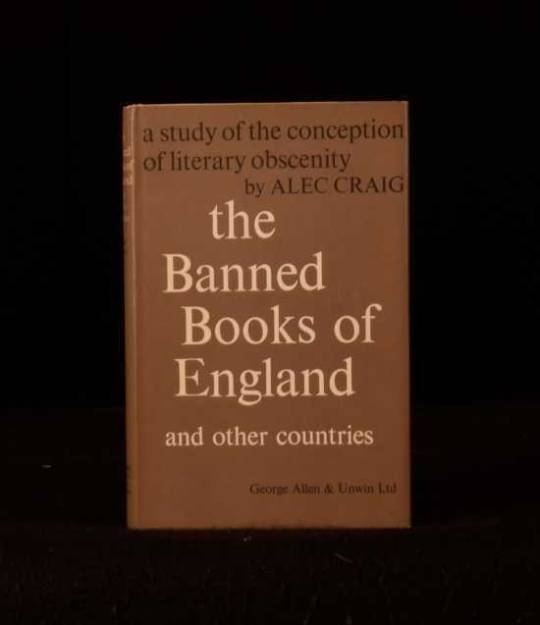
#banned books#censored books#banned#censored#banned books week#reading#love reading#freedom#freedom to read#love books#book lover#bibliophile#book blogger#book blog#antique books#bookseller#antique bookseller#first editions#D H Lawrence#Uncle Tom's Cabin#Droll Tales#Droll Stories
0 notes
Text
Arthur Rackham
The 19th September marks the 150th birthday of celebrated illustrator Arthur Rackham. During the ‘Golden Age’ of British book illustration Rackham was one of its leading artists. Many of the works he illustrated were published in a De Luxe limited edition in addition to a smaller trade edition.
Stylistically Rackham’s illustrations reflected pen and India ink drawings. He used expressive line paired with a subtle use of watercolour. Below are several examples of Rackham’s works from our ever-expanding library.
The first, and probably one of the most famous illustrated works by Rackham is Peter Pan in Kensington Gardens. We have a first edition of this work which is adorned with colour plates by Rackham. His ethereal designs compliment the magic of this tale. Click here to view our listing.
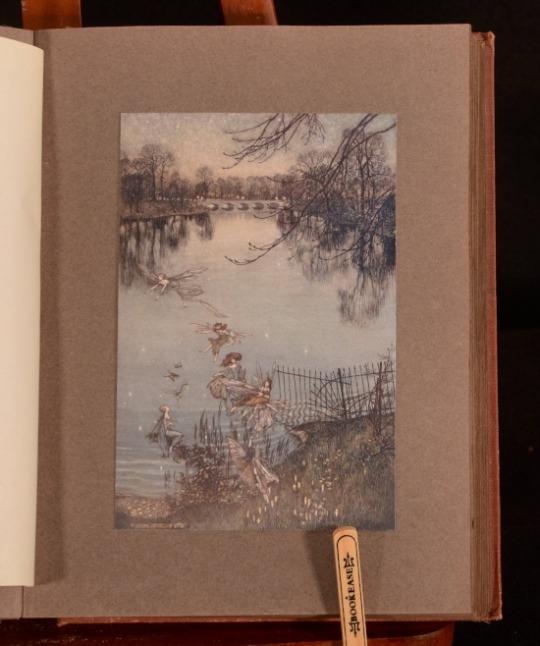
Another work illustrated by Rackham in our collection is this 1916 edition of Undine. This German fairy-tale novella features an under-water spirit who marries a knight to gain a soul. Translated from the original German of Friedrich de la Motte Fouque, this is a beautiful example of the work. Click here to view our listing.

Rackham illustrated many famous novels including Oliver Goldsmith’s The Vicar of Wakefield. We have recently acquired a copy of this illustrated work and it shall be on our website soon, so keep your eyes peeled!
In addition to works illustrated by Rackham we also have an interesting critical work titled Modern Book Illustrators and their Work. This title, edited by C Geoffrey Holme and Ernest G Halton discusses many famous illustrators throughout time including a chapter on Arthur Rackham. Click here to view our listing.
#Arthur Rackham#Illustrations#Pen and Ink#Watercolour#Undine#Peter Pan#Peter Pan in Kensington Gardens#Kensington#Kensington Gardens#Antique Books#Reading#On This Day#Illustrator#Rackham#De La Motte Fouque#Ethereal#Bibliophile#Booklr#Book Blog#Bookworm
1 note
·
View note
Quote
Ours is essentially a tragic age, so we refuse to take it tragically.
D H Lawrence, Lady Chatterley’s Lover
2 notes
·
View notes
Text
D H Lawrence
The 11th September marks the birth of David Herbert Lawrence. Born in 1885, D H Lawrence grew up to be a controversial yet progressive figure in the literary realm. Lawrence wrote novels, poems, plays and essays as well as being a literary critic and painter. Thematically his writings reflect on the dehumanising effects of modernity and industrialisation.
His views and writings brought official persecution and censorship resulting in a misrepresentation of his creative work which lead to his voluntary exile. It was not until after his death that his reputation was transformed and much of his works are now regarded as canonical.
In our library we have several works by Lawrence, mostly from the collection of Hugh Selbourne . Here are a few examples…
The book Lawrence is probably best known for is Lady Chatterley’s Lover. This is because of the obscenity trial that came hand in hand with its publication. There was a public prosecution of Penguin Books at Old Bailey under the Obscene Publications Act of 1959. This was because Penguin published an unexpurgated edition in 1960. Prior to this only heavily censored and abridged editions were published, first in America in 1928 and then by Penguin in 1946. The obscenity trial took six days and the jury found them not guilty which marked a change in the freedom of publishing explicit materials.
Here at Rooke we have the third edition of the censored publication published during Lawrence's lifetime. This is known as the standard edition of the text. Click here to view our listing.

We also have the first edition, fourth printing of The First Lady Chatterley. This work, published in New York, is the first draft of D H Lawrence’s work. This edition is interesting as the most commonly printed text is the third draft of his work. The work begins with a preface by Lawrence’s wife, Frieda. Click here to view our listing.
Following the initial publication of Lady Chatterley’s Lover Lawrence wrote his work Apropos of Lady Chatterley’s Lover. The work is a post-script whereby Lawrence uses this work to explain his novel, which had already caused some controversy. Click here to view our listing of this work.

Of course, Lady Chatterley’s Lover is not the only work written by Lawrence. He wrote many essays and works of literary criticism during his time. One particular work of interest is Lawrence’s essay Pornography and Obscenity. This work, published as a part of ‘Criterion Miscellany’ and is Number 5, explains his opinion on what should be considered obscene. Click here for our listing.
Another collection of essays by Lawrence in our library is Reflections on the Death of a Porcupine, and Other Essays. The work contains seven essays by Lawrence and is a limited edition number 394 of 475. The work is a first edition and has many essays reflecting on society and man. The work is in a lovely quarter cloth binding with marbled boards. Click here to view our listing.

Lawrence’s letters were also published and we have a first edition of this work. Numbered 433 of a 525 copy print-run this splendid work has an introduction by Aldous Huxley. It is housed in a slipcase and presents much of Lawrence’s correspondence. Click here for our listing .
We also have several first editions of other fictional works by Lawrence such as his first novel The White Peacock. This early work by Lawrence was inspired by the 1891 painting An Idyll by Maurice Greiffenhagen. Lawrence began the novel in 1906 and rewrote it three times. The early versions had the working title Laetitia. The work follows themes such as the damage of mismatched marriages and the border country between town and country. Our copy is the first UK edition which preceded the American edition by one day. Click here to view our listing.
We end this blog post with one of Lawrence’s final works published in his lifetime. The Virgin and the Gipsy is a short story collection. It was first published in a limited edition run and we have number 371 of 810 copies in this run. The work distils Lawrence’s views on sexuality and morality, joining characters together in their mutual passion, despite coming from different backgrounds and leading very different lives. The work is also known as The Virgin and the Gypsy, however the first edition, such as this, and many other early editions use the spelling 'Gipsy'. Click here to view our listing.
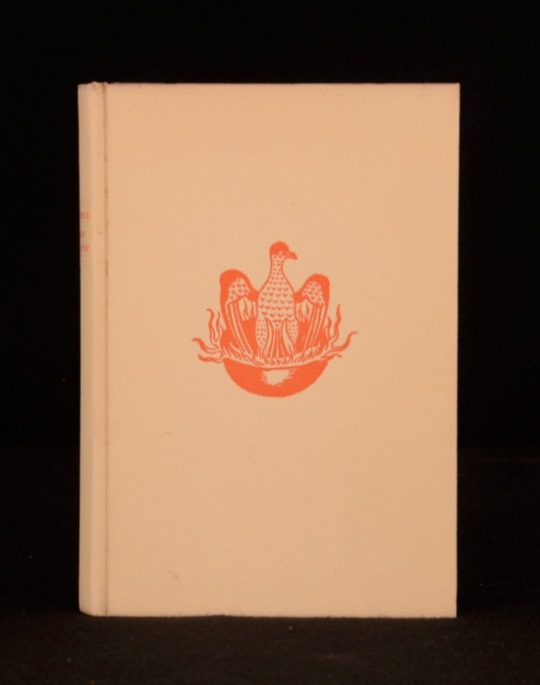
This is just a small sample of the many works by D H Lawrence we have in our library. Feel free to take a further look by clicking here or simply searching 'D H Lawrence' in our search bar
.
#D H Lawrence#On This Day#Lady Chatterley's Lover#Lady Chatterley#Reading#Booklist#Booklr#Books#bookworm#bookshop#first editions#1st edition#modern firsts#essays#litcrit#literary criticism#book reviews#antique books#limited edition
0 notes
Text
The Great Fire of London
Tuesday 5th September marked the anniversary of the end of the Great Fire of London. The 1666 blaze swept through the central portions of the city and gutted the medieval City of London. The fire destroyed 13,200 houses, 87 parish churches, St Paul’s Cathedral and many more buildings.
There has been much documentation and numerous literary works on the fire. We take this opportunity to take a look at several of the works we have in our library regarding the Great Fire of London. One of the most famous works regarding the Great Fire of London is the diary of Samuel Pepys. We have several copies of the work, such as this lovely morocco bound edition from George Bell and Sons:

Pepys is best known for this diary he kept as a young man. This is because it is one of the most important primary sources of the English Restoration period, which not only features the Great Fire of London but the Great Plague of London and the Second Dutch War. The portion of the diary on the fire relays that in the early hours of 2 September 1666 Pepys was awoken by his servant who spotted a fire in the Billingsgate area. Pepys felt that the fire was not serious and therefore returned to bed. Later that morning upon awaking his servant informed him of the damage thus far, 300 houses having been destroyed and the London Bridge being threatened. The diary describes in detail what Pepys witnessed during this time and is a fascinating account.
Click here to see our full collection of Pepys’ works.
Another contemporary diarist was John Evelyn. We have several copies and editions of Evelyn’s memoirs which have been said to rival those of Pepys. His diary, which he began at the age of eleven, bears witness to more than 50 years of English life. His diary is also of great value due to its primary recollection of key events in English history. The work remained unpublished until 1818. Unfortunately, over time his writings have been overshadowed by those of Samuel Pepys. His work should not be discredited as it holds the same merit.
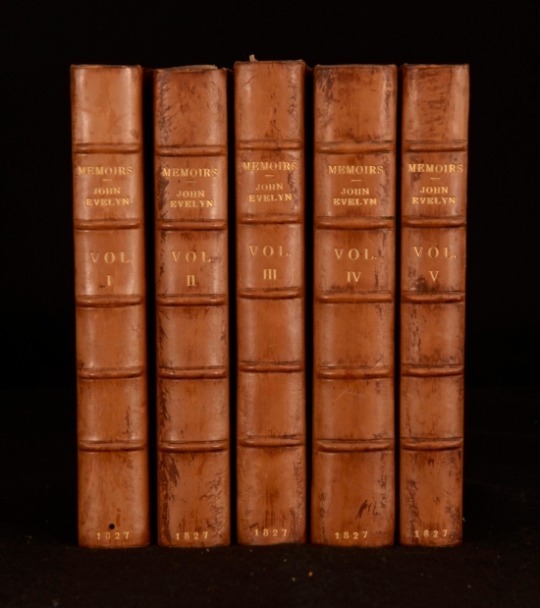
Click here to see more of Evelyn’s works.
Another historical work we have from this period is The City Remembrancer. The work is two volumes, bound as one. The first volume regards the Great Plague with the second volume discussing the Great Fire as well as the Great Storm of 1703. The historical work, published in 1769, was said to have been taken from Gideon Harvey’s papers. Harvey was a physician who published several medical works on diseases, including the plague. He was also the physician to the tower of London for fifty years.
Click here to view our listing.
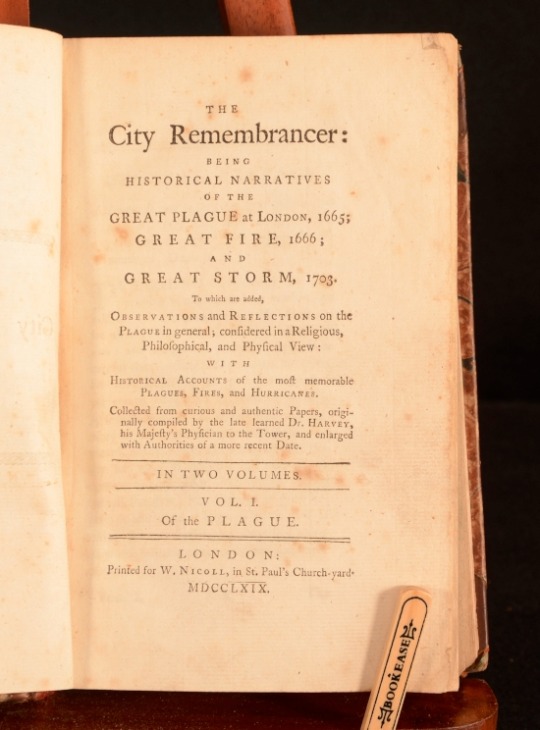
The history of this great and devastating fire has also made its mark in the realm of Historical Fiction. William Harrison Ainsworth was a popular nineteenth century historical novelist. He had a successful career in this field and wrote 39 novels in total. Ainsworth’s novel Old Saint Paul’s, A Tale of the Plague and the Fire is a literary romance that describes this historical event. The work details the life of a grocer named Stephen Bloundell. The novel is set near St Paul’s Cathedral and details its use as a place to house the sick during the plague and its destruction during the fire. We have one several copies of this work in our collection, including the first illustrated edition.

Click here to see our selection of Ainsworth’s writings, including several of Old Saint Paul’s.
Not only do we have several books regarding the fire, but we also have some works published the same year as the fire. One example of this is The Practick Part of the Law. The work provides an interesting insight into legal proceedings in the seventeenth century and is in a contemporary sheep binding.

If you have any questions regarding our books please don’t hesitate to contact us. Click here for our contact information.
#Great Fire of London#Fire of London#Pepys#Samuel Pepys#William Harrison Ainsworth#Love books#Book Lover#Reading#Book list#Reading List#Historical Fiction#History#Contemporary History#Bibliophile
0 notes
Text
History of Magic
Yesterday marked #19yearslater. For the muggles among us, the 1st September 2017 is the date featured in the epilogue to the final Harry Potter book. In this epilogue, it is nineteen years on from the Battle of Hogwarts and Harry is taking his son to King’s Cross Station to begin his journey at the magical school. This year also marks Harry Potter and the Philosopher’s Stone turning twenty years old. Thousands of people turned up to King's Cross station yesterday to mark the anniversary, which is further proof of how J K Rowling’s magical world has captivated audiences of all ages.
On the note of all things Potter, one of the subjects in the well-known series is ‘History of Magic’. This blog post shall briefly explore the history of magic in our own world, specifically stage or street magic. Street-magic differs from ritual magic and is strictly of the performative variety. We have also taken this opportunity to showcase some works on magic from our library.
Etymologically speaking, the term ‘magic’ actually derives from the Greek word mageia. This comes from rituals Persian priests would conduct during the Greek and Persian wars. The word soon came to mean anything unorthodox or illegitimate.
Magic is actually one of the oldest performing arts in the world, with the earliest books being Gantziony’s 1489 publication Natural and Unnatural Magic. Following this, the first book specifically referencing sleight of hand magic tricks in the English language was published in 1584 and was Reginald Scot’s The Discoverie of Witchcraft. Unfortunately, this work coincided with a national, religion fuelled fear of witchcraft and all procurable copies were burned when James I came to power in 1603. The work is very scarce today. Further works on magic tricks continued to be published during the 17th century and tricks were a very common source of entertainment at fairs. The average fair-goer of the seventeenth century could typically see spectacles such as sword swallowing, juggling and fire breathing.
With the decline in fear of witchcraft the 18th century performer became more respected and rich, private patrons wanted shows. We have a work in our library on experiments and natural philosophy. The title includes several spectacles that would be considered a branch of magic. It was very common in the 18th century to perform feats of magic under the guise of scientific exhibitions. One individual known for this was Jacob Philadelphia. The work we are referring to here is W Hooper’s Rational Recreations. We have a four volume set of this fascinating work which discusses a range of experiments from optics and chromatics to pneumatics and pyrotechnics. Click here to see our listing.

As time progressed the popularity of magic and illusions grew. The founding father of the modern entertainment magic we know today is widely considered to be Jean Eugene Robert-Houdin. Robert-Houdin was originally a clockmaker by profession and opened a magic theatre in Paris in 1845. He was one of the first to provide a specific arena for audiences to pay to see magic. The 19th century saw the development of magic as we know it today and many written works were produced to explain to audiences exactly how they are done. We have a book by Robert-Houdin providing the secrets behind many conjuring and magic tricks. The work provides step-by-step guides to various illusions such as coin tricks, cup and balls, handkerchief tricks and more. Click here to see our listing.

The above work was translated into English and edited by an English writer of magic books, Angelo John Lewis. The work was published under his pseudonym Professor Louis Hoffman. Our library has two other works by Hoffman, his 1904 title Later Magic and the 1893 work Puzzles old and New. Both works are illustrated and instruct the reader on many puzzles and tricks.
Hoffman was actually a lawyer and professor by profession. Despite being a leading author on magic he did not practise as a magician. His works are some of the earliest to explain, in English, many theories and practises of modern magic. He details the apparatus, tricks and methods of many magicians during that period.
Another 19th century work we have which focuses more on sleights, card deceptions and puzzles is The Boys Own Conjuring Book: Being a Complete Hand-Book of Parlour Magic. Click here for more information.
Audiences have been captivated and intrigued by magic for centuries. Stage illusions and magic shows are still incredibly popular today and the tricks explained in these books are still performable and of interest today, despite being written over 100 years ago. For us mere muggles who aren’t able to go to Hogwarts, I suppose it will have to do!
#19 years later#potterhead#harry potter#bookblog#bookblogger#bookworm#magic#magic books#history of magic#potter#pottermore#houdin#houdini#magic tricks#reading#antique books#booklr#bibliophile#rooke books
0 notes
Photo

📚
#finebinding#finebindingfriday#fine books#leather bound books#reading#bibliophile#library#shelfie#beauty#gilted#gilding#book lover#bookshelf#bookshop#book blog#booklr#antiquarian#antique#antique books#book lovers#book lovers day#beautiful books
6 notes
·
View notes
Photo
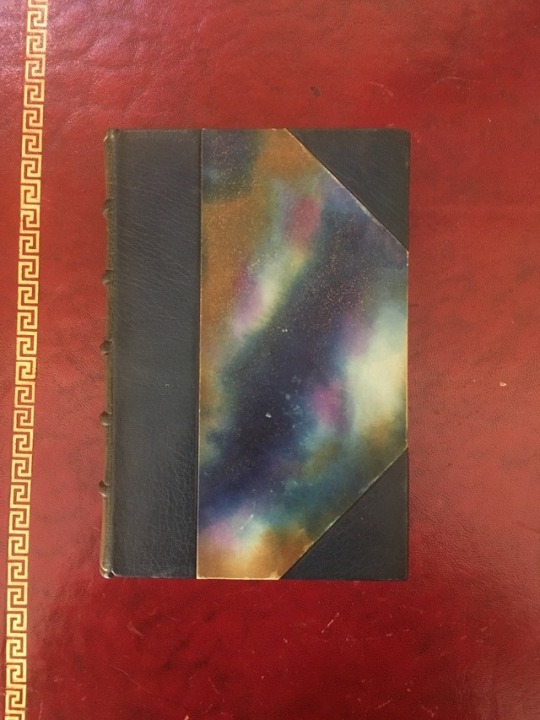
Galaxy Marbling
1 note
·
View note
Photo

It's marbled Monday
#marbledmonday#marbledpaper#papermarbling#bookaesthetic#beautiful books#finebinding#art#books#antiquebooks#marbled paper#paper making
0 notes
Text
Typography, Baskerville and the Oscars
This post shall begin with a tenuous link to a seemingly gargantuan gaffe of the year; the Oscars ‘scandal’. It has been said that the blunder of this year’s Oscars (where the wrong film was announced for the ‘Best Picture’ award) could have been avoided if the organisers had cared more about the typography and design of the cards. A different typographical setting would have made the cards easier to read and therefore the presenter could have identified that they had the incorrect card. Typography is an art form, a (what should be) carefully thought about process in so many things we see in everyday life, especially for us at Rooke because.. well.. books..
Without typography, or typefaces, the manufacturing of books would not be possible. We would all still be reading hand-produced work which would have a very small circulation. The first moveable typeface was established in the 1400s by Guttenberg. It was a much cheaper way to produce the written word on a larger scale. Guttenberg also created the first typeface, Blackletter. The Blackletter typeface is somewhat gothic in style and rather thick. It was based on hand-written scripts and the style dates back to approximately 1150. Following this new innovative type, several typefaces were produced including Aldus Manutius’ italic typeface and Nicholas Jenson’s Roman Type.
The development and progression in typeface is paralleled with technological advances as well as cultural change. By the eighteenth century real change began with contrasting between bold and thin strokes. The mid eighteenth century saw the development of transitional type, and in particular, the Baskerville typeface. Transitional typefaces represent the move from the Old Style tradition (such as Blackletter and Roman) and immediately predate the Modern period of typeface of Firmin Didot and Giambattista Bodoni. Baskerville is often seen as a chief influence and pioneer in the transitional typeface in addition to other significant printing innovations.
John Baskerville started his working life as a businessman in the field of japanning and papier mache. Prior to this he was a calligraphy teacher and gravestone carver. Baskerville cared a lot about typography and the quality of work. He believed that he could produce printed texts to a higher quality than was already widely produced and to produce clearer typography there needed to be a better typeface. The Baskerville typeface showed a larger contrast between thick and thin strokes, producing sharper serifs. There was also a shift in the axis of rounded letters to a more vertical position. In comparison to previous works Baskerville’s typeface provided a greater consistency in size and form. The first work he produced with this typeface was his quarto edition of Virgil on his own wove paper. It was due to this work, which took three years to complete, that he was appointed as printer to the University of Cambridge.
Further innovations in printing made by Baskerville includes a technique to produce a smoother whiter paper to showcase his strong black type called wove. He also worked on developing ink formulas capable of producing denser and a richer black colour. He also built a sturdier press from metal, capable of a more even and meticulous pressure. As well as these developments in printing, Baskerville also made a bold advance and change in typography, by adding wide margins and leading between each line. His type and printing techniques can be seen in the copies of Paradise Lost and Paradise Regained we have on our website. We have the first Baskerville editions of these epic, blank verse poems by John Milton. Paradise Lost and Paradise Regained were some of the earliest works Baskerville printed in his typeface, both are dated 1758. To his preface of Paradise Lost he explains his mission in typography, printing and typeface revolution.
Baskerville worked hard to produce a new method of printing and typography. Transitional typefaces and methods like his helped to pave the way for further development into the more modern type. Referring back to my questionable introduction, Baskerville would probably not be impressed with the somewhat lackadaisical approach to the typography of the Oscars’ award cards. It is also quite possible that the Oscars could have learnt from paying closer attention to typography when designing their award cards. Alternatively, they could have given the correct card to the presenter.

#sorry not sorry#oscars 2017#mistype#misread#la la land#moonlight#baskerville#typeset#history of type#history#book history#reading#booklr#history of the book#john baskerville#paradise lost#john milton#typography#oscars mistake
0 notes
Photo

😍
88 notes
·
View notes
Photo
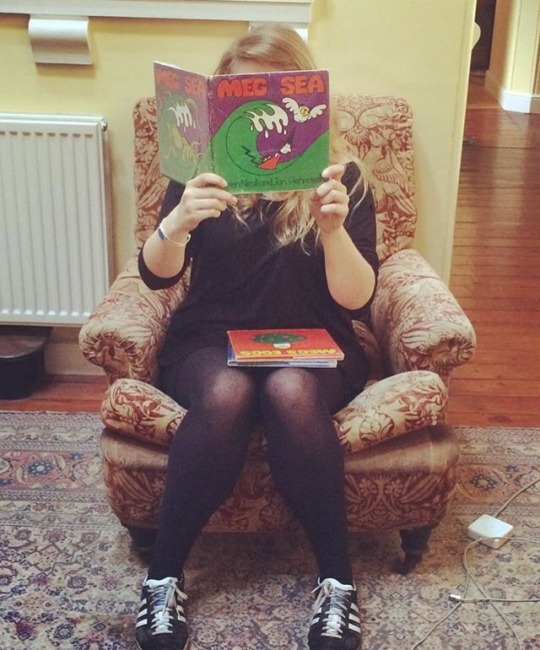
Happy #picbookday
0 notes
Photo

Festive Foredge Friday!
#festive#foredge#foredgefriday#book lovers#reading#booklr#bookstagram#gilt#gilted#pretty#bookworm#baubles#Christmas
1 note
·
View note